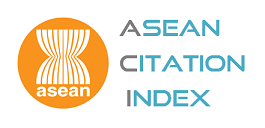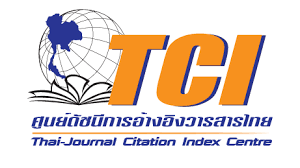Social Determinants of Health Predicting Asthma Control in Patients with Asthma
DOI:
https://doi.org/10.60099/jtnmc.v40i02.271796Keywords:
social determinants of health, asthma control, environment, medication adherence, barriers to healthcare accessAbstract
Introduction Despite the advancements in asthma treatment approaches and medications, the prevalence rate of good asthma control remains low, leading to hospitalizations and emergency visits from exacerbations among patients. The primary goals of asthma control are to reduce emergency visits and hospitalizations due to acute asthma exacerbations and to improve quality of life. The social determinants of health affecting asthma control were the focus of this study, which will lead to more effective short-term and long-term asthma control approaches.
Objective This study aimed to examine factors including income sufficiency, health literacy, environments at risk of asthma exacerbation, adherence to inhaled corticosteroids, fear of asthma symptoms, and barriers to receiving care in predicting asthma control that predict asthma control in patients with asthma.
Design This study was descriptive research with a cross-sectional design, using the concept of social determinants of health as the conceptual framework, explaining that a person’s disease control is not merely influenced by individual, genetic, physiological, or behavioral factors. It may also be caused by social and environmental factors in which a person lives. These factors may contribute to differences in health determinants among individuals, ultimately influencing health outcomes and health equity.
Methodology The sample consisted of 130 asthma patients who attended follow-up appointments at the outpatient department of a tertiary hospital in Bangkok from February to April 2024. The sample size was determined using power analysis principles with the G*Power software for logistic regression analysis. The significance level was set at an alpha (α) of .05, the power of test at .80, and an odds ratio of 3.64, based on previous research studying adherence to inhaled corticosteroids and clinical control outcomes in asthma patients. Through purposive sampling, the inclusion criteria were 1) aged 20 years and older and 2) diagnosed with asthma and used inhaled corticosteroids for at least 3 months. Instruments included a personal information and medical history questionnaire, the Hill-Bone Medication Adherence Scale (HB-MAS), the Environment at Risks of Asthma Exacerbation Questionnaire, the Barriers to Receiving Care Questionnaire, the Fear of Asthma Symptoms Scale (FAS), the short version of the European Health Literacy Survey (HLS-EU-Q16), and the Asthma Control Questionnaire based on the GINA guideline 2023. The quality of the instruments was evaluated by determining their reliability. The Cronbach’s alpha coefficients were used for assessing the reliability of the research instruments as follows: the HB-MAS, the Environment at Risks of Asthma Exacerbation Questionnaire, the Barriers to Receiving Care Questionnaire, and the FAS were equal to .83, .71, .75, and .87, respectively. Additionally, the Kuder-Richardson-20 was used to assess the reliability of the HLS-EU-Q16 and the Asthma Control Questionnaire, obtaining values of .87 and .83, respectively. Data were collected using self-administration and were analyzed using descriptive statistics and logistic regression.
Results More than half of the sample was aged 60 – 79 years (56.10%) and female (66.90%). Less than half of the sample (39.20%) had a monthly income of less than 10,000 baht, while 43.10% had insufficient income. The factors correlated with asthma control were found to be environments at risk of asthma exacerbation (c2 = 20.615, p < .001), adherence to inhaled corticosteroids (c2 = 16.830, p < .001), fear of asthma symptoms (c2 = 14.282, p < .001), and barriers to receiving care (c2 = 13.593, p < .001). Environments at risk of asthma exacerbation and adherence to inhaled corticosteroid use were able to predict asthma control with statistical significance (OR = 7.08, 95%CI = 2.27, 22.08, p < .001 and OR = 13.15, 95%CI = 2.21, 78.18, p = .005, respectively).
Recommendation According to the findings in this study, nurses should prioritize the assessment of environmental factors and patient adherence to inhaled corticosteroid use. This approach enables asthma patients to avoid risky environments and promotes adherence to inhaled corticosteroid use.
Downloads
References
National Center for Health Statistics. Percentage of current asthma for adults aged 18 and over, United States, 2023: National Health Interview Survey. Generated interactively [internet]. 2023 [cite 16 Feb 2025]. Available from: https://wwwn.cdc.gov/NHISDataQueryTool/SHS_adult/index.html
Ministry of Public Health. Standard reporting group >> Diseases from air pollution >> Number of illnesses classified by disease group and disease by month with diseases related to air pollution from 2022 to 2024 [internet]. 2024 [cite 16 Feb 2025]. Available from: https://hdcservice.moph.go.th/hdc/reports/report.php?&cat_id=9c647c1f31ac73f4396c2cf987e7448a&id=5968980caf87d4518aa9f0263a9299c6&old=1.
Global Initiative for Asthma. Global strategy for asthma management and prevention update 2023 [internet]. 2023 [cite 29 May 2023]. Available from: http://www.ginasthma.org
Witheethammasak P, Deenan A, Masingboon K. A causal model of asthma control in adults. PRIJNR [internet]. 2022 [cite 25 Aug 2023]; 26(4):613-26. Available from: https://he02.tci-thaijo.org/index.php/PRIJNR/article/view/259266
Yotmon K. The factors predicting the level of asthma control among adult and elderly asthmatic patients [Dissertation]. Thammasat University. Faculty of Nursing; 2021. (in Thai)
Chootrakool A. Prevalence and factors associated with the level of asthma control in patients treated at asthma clinic, Pak Chong Nana Hospital, Nakhon Ratchasima Province. Nakhonphanom Hospital Jorunal [internet]. 2023 [cite 10 Nov 2023]; 10(2):e263917. Available from: https://he01.tci-thaijo.org/index.php/nkpjournal_9/article/view/263917 (in Thai)
Neffen H, Chahuàn M, Hernández DD, Vallejo-Perez E, Bolivar F, Sánchez MH, et al. Key factors associated with uncontrolled asthma – the asthma control in Latin America study. Journal of Asthma 2020;57(2): 113-22. https://doi.org/10.1080/02770903.2018.1553050 PMID: 30915868
Yaghoubi M, Adibi A, Safari A, FitzGerald JM, Sadatsafavi M. The projected economic and health burden of uncontrolled asthma in the United States. Am J Respir Crit Care Med 2019;200:1102-12. https://doi.org/10.1164/rccm.201901-0016OC. PMID: 31166782
Belachew EA, Netere AK, Sendekie AK. Adherence to inhaled corticosteroid therapy and its clinical impact on asthma control in adults living with asthma in Northwestern Ethiopian hospitals. Patient Prefer Adherence 2022;16:1321-32. https://doi.org/10.2147/PPA.S365222 PMID: 35642244
Cai Q, Jin M, Li X, Zhang J, Xu Q, Ye L, et al. Effect of illness perceptions on asthma control and quality of life amongst adult outpatients with asthma in China. BMC Psychol 2023;11:68. https://doi.org/10.1186/s40359-023-01097-3 PMID: 36907916
Greaves CJ, Eiser C, Seamark D, Halpin DMG. Attack context: An important mediator of the relationship between psychological status and asthma outcomes. Thorax 2002;57:217-21. https://doi.org/10.1136/thorax.57.3.217 PMID: 11867824
Jaakkola MS, Hyrkäs-Palmu H, Jaakkola JJK. Residential exposure to dampness is related to reduced level of asthma control among adults. Int J Environ Res Public Health 2022;19(18):11338. https://doi.org/10.3390/ijerph191811338 PMID: 36141610
Kim Cuc DT, Methakanjanasak N, Thuy Trang HT. Relationships between symptom control, medication management, and health literacy of patients with asthma in Vietnam. Belitung Nurs J 2021;7(2):131-8. https://doi.org/10.33546/bnj.1398 PMID: 37469948
Makhinova T, Barner JC, Brown CM, Richards KM, Rascati KL, Rush S, et al. Examination of barriers to medication adherence, asthma management, and control among community pharmacy patients with asthma. J Pharm Pract 2021;34(4):515-22. https://doi.org/10.1177/0897190020902889 PMID: 30947599
Salim H, Shariff Ghazali S, Lee PY, Cheong AT, Harrun NH, Mohamed Isa S, et al. Health literacy levels and its determinants among people with asthma in Malaysian primary healthcare settings: A crosssectional study. BMC Public Health 2021;21:1186. https://doi.org/10.1186/s12889-021-11194-w PMID: 34158013
Scibor M, Balcerzak B, Galbarczyk A, Jasienska G. Quality of life of patients with bronchial asthma exposed to gaseous air pollution in the place of residence. Sustainable Cities and Society 2021;64:102541. https://doi.org/10.1016/j.scs.2020.102541
Song WJ, Won HK, Lee SY, Park HK, Cho YS, Chung KF, et al. Patients’ experiences of asthma exacerbation and management: A qualitative study of severe asthma. ERJ open research 2021;7(2):00528. https://doi.org/10.1183/23120541.00528-2020 PMID: 33834052
World Health Organization. A conceptual framework for action on the social determinants of health: Social determinants of health discussion paper 2 (policy and practice) [internet]. Switzerland: WHO Document Production Services; 2010 [cite 27 May 2023]. Available from: https://apps.who.int/iris/handle/10665/44489
Cardet JC, Louisias M, King TS, Castro M, Codispoti CD, Dunn R, et al. Income is an independent risk factor for worse asthma outcomes. J Allergy Clin Immunol 2018;141(2):754-60. https://doi.org/10.1016/j.jaci.2017.04.036 PMID: 28535964
Yekusang R, Kuhirunyaratn P, Bumrerraj S, Jindawong B. Factors related asthma exacerbations of asthmatic patients in Surat Thani province. KKU Research Journal (Graduate Studies) [internet]. 2022 [cite 22 Aug 2023]; 22(3):212-25. Available from: https://ph02.tci-thaijo.org/index.php/gskku/article/view/245064 (in Thai)
Sørensen K, Van den Broucke S, Fullam J, Doyle G, Pelikan J, Slonska Z, et al. Health literacy and public health: A systematic review and integration of definitions and models. BMC Public Health 2012;12:80. https://doi.org/10.1186/1471-2458-12-80 PMID: 22276600
Konstantakopoulou O, Kaitelidou D, Economou C, Charalambous G. Barriers in access to pharmaceutical care in Greece: The case study of the out-of-hospital management of patients with acute asthma. Front Public Health 2018;6:199. https://doi.org/10.3389/fpubh.2018.00199 PMID: 30065920
Freels L, Herman A, Lukas S, Chan AHY, Pearce CJ, Arackal J, et al. Asthma control and associated risk factors among adults with current asthma: Findings from 2019 behavioral risk factor surveillance system asthma call-back survey. Respir Med 2024;221: 107479. https://doi.org/10.1016/j.rmed.2023.107479 PMID: 38013060
Faul F, Erdfelder E, Buchner A, Lang AG. Statistical power analyses using G*Power 3.1: tests for correlation and regression analyses. Behav Res Methods 2009; 41:1149-60. https://doi.org/10.3758/BRM.41.4.1149 PMID: 19897823
Borson S, Scanlan J, Brush M, Vitaliano P, Dokmak A. The mini-cog: A cognitive ‘vital signs’ measure for dementia screening in multi-lingual elderly. Int J Geriatr Psychiatry 2000;15:1021-7. https://doi.org/10.1002/1099-1166(200011)15:11<1021::aid-gps234>3.0.co;2-6 PMID: 11113982
Trongsakul S, Lambert R, Clark A, Wongpakaran N, Cross J. Development of the Thai version of Mini-Cog, a brief cognitive screening test. Geriatr Gerontol Int 2015;15:594-600. https://doi.org/10.1111/ggi.12318 PMID: 25155468
Tanukaew D, Watanakijkrilert D, Sriyuktasuth A, Chattranukulchai P. Factors predicting medication adherence in patients with essential hypertension. Thai Red Cross Nursing Journal [internet]. 2022 [cite 22 Jul 2023]; 15:127-43. Available from: https://he02.tci-thaijo.org/index.php/trcnj/article/view/ 247347 (in Thai)
Kim MT, Hill MN, Bone LR, Levine DM. Development and testing of the Hill-Bone Compliance to High Blood Pressure Therapy Scale. Prog Cardiovasc Nurs 2000;15(3):90-6. https://doi.org/10.1111/j.1751-7117.2000.tb00211.x PMID: 10951950
Bonnert M, Roelstraete B, Bergstrom S-E, Bjureberg J, Andersson E, Almqvist C. The Fear of Asthma Symptoms Scale and the Asthma Behavior Checklist: Preliminary validity of two novel patient reported outcome measures. J Asthma 2023;60(8):1-8. https://doi.org/10.1080/02770903.2022.2160343 PMID: 36541867
Wattanakitkrileart D, Khongton W, Sumonviwat T, Dejsomritrutai W. The influence of inhaler technique, exacerbation, age, and barrier to receiving care on adherence to inhaled medications in patients with COPD. Nursing Science Journal of Thailand [internet]. 2020 [cite 20 Jul 2023]; 38(2):74-87. Available from: https://he02.tci-thaijo.org/index.php/ns/article/view/241059 (in Thai)
Thoracic Society of Thailand under Royal Patronage. Asthma Thai guideline 2023 [internet]. 1st ed. Bangkok: Parbpim; 2023 [cite 28 May 2023]. Available from: https://www.tst.or.th/wp-content/uploads/2023/05/Asthma-Thai-guideline-2566-PDF-final-.pdf (in Thai)
Junphongsri P, Wattanakitkrileart D, Phligbua W, Dejsomritrutai W. Factors predicting disease control in patients with asthma, Banphaeo General Hospital, Samut Sakhon. Nursing Science Journal of Thailand [internet]. 2024 [cite 10 May 2024]; 42(2):32-45. Available from: https://he02.tci-thaijo.org/index.php/ns/article/view/265946 (in Thai)
Office of the National Economic and Social Development Council. Thai Economic Performance 2023 [Internet]. 2023 [cite 1 Jun 2023]. Available from: https://www.nesdc.go.th/ewt_news.php?nid=12567. (in Thai)
Bangkok Metropolitan Administration. PM 2.5 in Bangkok 2024. 2024 [cite 20 May 2024]. Available from: https://airquality.airbkk.com/PublicWebClient/#/Modules/Aqs/NewsPage (in Thai)
Downloads
Published
How to Cite
Issue
Section
License
Copyright (c) 2025 Journal of Thailand Nursing and Midwifery Council

This work is licensed under a Creative Commons Attribution-NonCommercial-NoDerivatives 4.0 International License.








